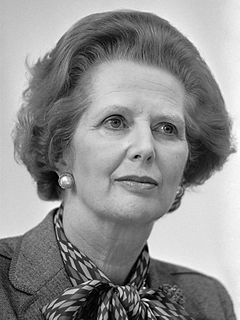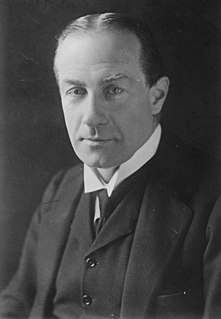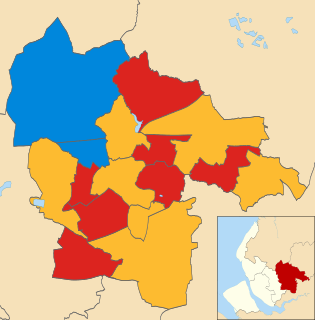Liberal-Labour may refer to:
| This disambiguation page lists articles associated with the title Liberal-Labour. If an internal link led you here, you may wish to change the link to point directly to the intended article. |
Liberal-Labour may refer to:
| This disambiguation page lists articles associated with the title Liberal-Labour. If an internal link led you here, you may wish to change the link to point directly to the intended article. |

The 2001 United Kingdom general election was held on Thursday 7 June 2001, four years after the previous election on 1 May 1997, to elect 659 members to the House of Commons. Under the leadership of Tony Blair, the Labour Party was re-elected to serve a second term in government with another landslide victory, returning 413 of the 418 seats won by the party in the previous general election in 1997, a net loss of 5 seats, though with a significantly lower turnout than before — 59.4%, compared to 71.3% at the previous election. Blair went on to become the first Labour Prime Minister to serve a consecutive full term in office. As Labour retained much of their 1997 landslide victory, the 2001 election was dubbed "the quiet landslide" by the media.

The Liberal Party was one of the two major parties in the United Kingdom with the opposing Conservative Party in the 19th and early 20th centuries. The party arose from an alliance of Whigs and free trade-supporting Peelites and the reformist Radicals in the 1850s. By the end of the 19th century, it had formed four governments under William Gladstone. Despite being divided over the issue of Irish Home Rule, the party returned to government in 1905 and then won a landslide victory in the following year's general election.

The 1983 United Kingdom general election was held on Thursday 9 June 1983. It gave the Conservative Party under the leadership of Margaret Thatcher the most decisive election victory since that of the Labour Party in 1945.

The 1987 United Kingdom general election was held on Thursday, 11 June 1987, to elect 650 members to the House of Commons of the United Kingdom. The election was the third consecutive general election victory for the Conservative Party, and second landslide under the leadership of Margaret Thatcher, who became the first Prime Minister since the Earl of Liverpool in 1820 to lead a party into three successive electoral victories.

The October 1974 United Kingdom general election took place on Thursday 10 October 1974 to elect 635 members of the British House of Commons. It was the second general election held that year, the first year that two general elections were held in the same year since 1910, and the first time that two general elections were held less than a year apart from each other since the 1923 and 1924 elections, which took place 10 months apart. The election resulted in the Labour Party led by Harold Wilson winning the narrowest majority recorded, 3 seats. This enabled the remainder of the Labour government, 1974–1979 to take place, which saw a gradual loss of majority.

The 1964 United Kingdom general election was held on 15 October 1964, five years after the previous election, and thirteen years after the Conservative Party, first led by Winston Churchill, had entered power. It resulted in the Conservatives, led by its fourth leader, Sir Alec Douglas-Home, narrowly losing the election to the Labour Party, led by Harold Wilson, with Labour having an overall majority of four seats. It resulted in Labour ending its thirteen years in opposition and led to Wilson to become, at the time, the youngest Prime Minister in more than 150 years.

The 1950 United Kingdom general election was the first general election ever to be held after a full term of Labour government. The election was held on Thursday 23 February 1950. Despite polling over 700,000 votes more than the Conservatives, and receiving more votes than they had during the 1945 general election, Labour obtained a slim majority of just five seats—a stark contrast to 1945, when they had achieved a landslide, 146-seat majority. There was a national swing towards the Conservatives, who gained 90 seats. Labour called another general election in 1951.

The 1935 United Kingdom general election was held on Thursday 14 November 1935 and resulted in a large, albeit reduced, majority for the National Government now led by Stanley Baldwin of the Conservative Party. The greatest number of members, as before, were Conservatives, while the National Liberal vote held steady. The much smaller National Labour vote also held steady but the resurge in the main Labour vote caused over a third of their MPs, including National Labour leader Ramsay MacDonald, to lose their seats.

The 1931 United Kingdom general election was held on Tuesday 27 October 1931 and saw a landslide election victory for the National Government which had been formed two months previously after the collapse of the second Labour government. Collectively, the parties forming the National Government won 67% of the votes and 554 seats out of 615. The bulk of the National Government's support came from the Conservative Party, and the Conservatives won 470 seats. The Labour Party suffered its greatest defeat, losing four out of five seats compared with the previous election. The Liberal Party, split into three factions, continued to shrink and the Liberal National faction never reunited. Ivor Bulmer-Thomas said the results "were the most astonishing in the history of the British party system". It is the most recent election in which one party received an absolute majority of the votes cast and the last UK general election not to take place on a Thursday. It would be the last election until 1997 in which a party won over 400 seats in the House of Commons.

The 1924 United Kingdom general election was held on Wednesday 29 October 1924, as a result of the defeat of the Labour minority government, led by Ramsay MacDonald, in the House of Commons on a motion of no confidence. It was the third general election to be held in less than two years.

The 1923 United Kingdom general election was held on Thursday 6 December 1923. The Conservatives, led by Stanley Baldwin, won the most seats, but Labour, led by Ramsay MacDonald, and H. H. Asquith's reunited Liberal Party gained enough seats to produce a hung parliament. It is the most recent such election in which a third party won over 100 seats. Likewise the highest percentage, 26%, of the vote of any such party.

The 1906 United Kingdom general election was held from 12 January to 8 February 1906.
In British politics, a Lib–Lab pact is a working arrangement between the Liberal Democrats and the Labour Party.

The 2005 United Kingdom general election was held on Thursday 5 May 2005, to elect 646 members to the House of Commons. The Labour Party led by Tony Blair won its third consecutive victory, with Blair becoming the only Labour leader beside Harold Wilson to form three majority governments. However, its majority now stood at 66 seats compared to the 160-seat majority it had previously held. As of 2019, it remains the last general election victory for the Labour Party.
The Liberal–Labour movement refers to the practice of local Liberal associations accepting and supporting candidates who were financially maintained by trade unions. These candidates stood for the British Parliament with the aim of representing the working classes, while remaining supportive of the Liberal Party in general.

The 2007 St Helens Metropolitan Borough Council election took place on 3 May 2007 to elect members of St Helens Metropolitan Borough Council in Merseyside, England. One third of the council was up for election and the council stayed under no overall control.

Liberal–Labour was a political association in New Zealand in the last decade of the nineteenth and first half of the twentieth centuries.